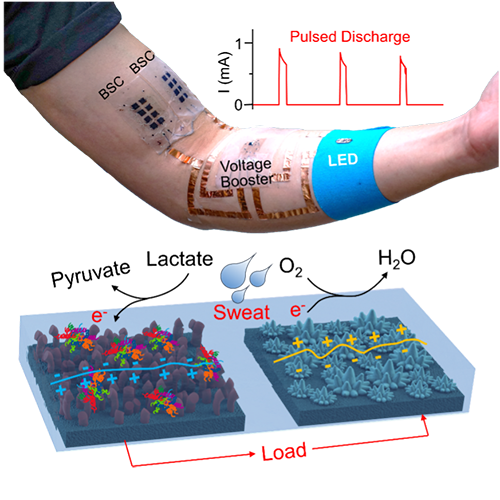| Jul 08, 2021 | |
Dual-functional epidermal patch with capability of harvesting and storing the energy in sweat |
|
| (Nanowerk Spotlight) Self-charging biosupercapacitors (BSCs) that can store energy and be self-charged via chemical or solar energy conversion through bioreaction have recently attracted considerable attention. As human sweat also contains a high concentration of lactate biofuel, the harvesting and storage of the bioenergy in sweat holds the potential to provide the power for wearable electronics. | |
| However, materials utilized in previous BSCs are either bulky, rigid, or fragile, and therefore cannot serve as suitable candidates for stretchable conformal wearable electronic devices. For a wearable BSC, the flexibility, stretchability, and skin conformity of the device are of considerable importance. | |
| Prof. Joseph Wang’s group in UC San Diego demonstrates the first example of an all-printed dual-functional stretchable and wearable BSC, fabricated on top of low-elastic modulus and adhesive elastic films, to harvest and store energy from sweat while maintaining intimate contact with the human skin (Advanced Functional Materials, "Wearable Biosupercapacitor: Harvesting and Storing Energy from Sweat"). | |
| This wearable hybrid device, functioning as both a biofuel cell and a supercapacitor, is demonstrated to deliver high-power pulses and be rapidly self-recharged using enzymatic oxidation of lactate biofuel from human perspiration. | |
| This work enabled material-level integration of both functionalities on the same set of electrodes, thus reducing the system complexity and minimizing the device footprint. | |
 |
|
| Demonstration of epidermal BSCs for powering wearable electronics and the working mechanism of the sweat BSC. (Reprinted with permission by Wiley-VCH Verlag) | |
| A scalable and low-cost screen-printing process, using stress-enduring inks, is used to fabricate the BSC (combining the biofuel cell and supercapacitor functions on the same printed anode and cathode) and meeting the softness, stretchability, and scalability requirements for this skin-worn wearable device. | |
| The stable, conformal, and stretchable energy harvesting-storage dual-function device has been realized through the highly efficient planar electrode design with an “island-bridge” structure and the use of such strain-enduring inks. | |
| The island-bridge structure is fabricated on a soft silicone rubber substrate; a non-elastic backbone layer is printed at the bottom of the active electrode “islands” for mechanical support, while silver interconnections are printed in serpentine patterns as “bridges”. | |
| The stress in the electrode area is thereby distributed to the surrounding flexible region when the device is under deformation, hence ensuring attractive mechanical resiliency. | |
| Compared to the common lactate/O2 biofuel cells, the greatly enhanced capacitance of the BSC is achieved by the synergistic effect of the CNT-based ink and the electrodeposited polypyrrole (PPy) conductive polymer on the anode and of the high-surface-area cauliflower-like structured porous Pt on the cathode. | |
| The resulting wearable dual-functional BSC can support high-power pulsed output while maintaining stable charge–discharge performance in human sweat-level lactate. The self-rechargeable hybrid device demonstrated harvesting high power up to 1.7 mW cm−2 and can be mounted on user's arm for energy harvesting. | |
| When paired with voltage regulation components, commercial electronics, such as LEDs, can be successfully illuminated in pulsed mode by the designed BSC, suggesting its considerable potential as a power source for the next generation of wearable devices, such as insulin pump or wireless transmitters. | |
| As a wearable device with enzymatic electrodes, its stability may be affected by environmental factors, such as temperature, pH, salt ions, or surfactants, which will be assessed in the future. Future efforts will further optimize the operational conditions, cell performance, and electronics integration for advancing the capabilities and applications of this novel dual-functional self-charging device. | |
| Source: Provided as a Nanowerk exclusive by Dr. Jian Lyu, Department of NanoEngineering, University of California San Diego | |
|
Become a Spotlight guest author! Join our large and growing group of guest contributors. Have you just published a scientific paper or have other exciting developments to share with the nanotechnology community? Here is how to publish on nanowerk.com. |
|
